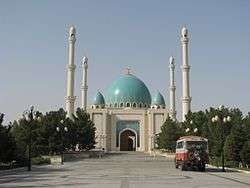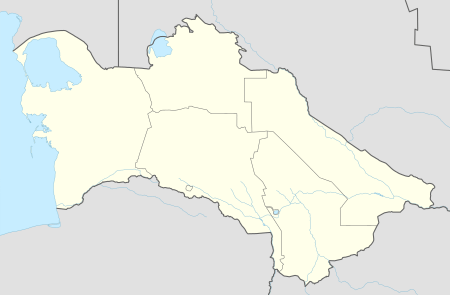Geok Tepe
Geok Tepe, Gökdepe or Gokdepe is a former fortress of the Turkmens, in Turkmenistan, in the oasis of Ahal, on the Transcaspian railway, 45 kilometres (28 mi) north-west of Ashgabat. It is the Russian version of the Turkic name Gökdepe meaning "Blue Hill" from the Turkmen gök "blue" and depe "hill" or "summit".[1] Today it lies along the M37 highway.
Geok Tepe Gökdepe | |
|---|---|
 Saparmurat Hajji Mosque | |
 Geok Tepe Location in Turkmenistan | |
| Coordinates: 38°09′28″N 57°57′59″E | |
| Country | |
| Province | Ahal Region |
| District | Gökdepe District |
| Population (2010) | |
| • Total | 21,465 |
History
The fortress consisted of a walled enclosure 2.8 km (1 3⁄4 mi) in circuit, the wall being 5.5 m (18 ft) high and 6 to 9 m (20 to 30 ft) thick. In December 1880 Geok Tepe was attacked by 6,000 Russians under General Mikhail Skobelev against 25,000 defenders. The siege of Geok Tepe lasted 23 days, after which the city was taken by storm. Although they encountered heavy resistance, the Russian forces eventually broke in by digging a tunnel under the wall, then detonating a mine underneath the wall. On January 12 (24th new style), 1881, the mine was detonated. Once the fortress was breached, the Russian troops stormed in. Several hundred defenders were killed in the initial explosion, and many more were killed in the fighting that ensued.[2] Eventually, the defenders, along with the 40,000 civilians inside the fortress, fled across the desert, pursued by General Skobelev's cavalry. Around 8,000 Turkmen soldiers and civilians were killed during flight, along with an additional 6,500 that had died inside the fortress. Russian casualties were 398 killed and 669 wounded.
Legacy
- Saparmurat Hajji Mosque was built to commemorate the defeat and is noted for its mint-turquoise blue coloured roof and white marble structure
- Halk Hakydasy Memorial Complex
References
- Concise Dictionary of World Place-Names, 2005
- The legal historian Sir Henry Maine discussed the incident in his last lectures. Maine, Henry (1888). International Law: A Series of Lectures Delivered Before the University of Cambridge, 1887 (1 ed.). London: John Murray. pp. 143–144. Retrieved 24 January 2016.